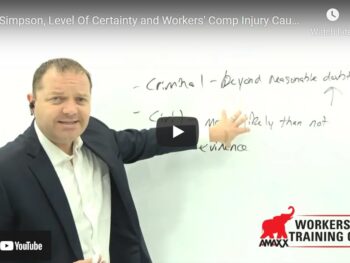“Defense in depth” is a principal from conflict theory which promotes using several defenses in coordination instead of seeing them as separate defenses to be used one at a time. Sometimes, the phrase “mutually supporting” is used.
In work comp hearings, defense issues often are identified and documented but they are not processed so that the use in hearings is enhanced. In addition an investigation will be halted when “enough” evidence is obtained or, worse, when one defense has so much evidence that an investigation will be halted before additional issues are located.
In Hearings Nearly All Doubts Are Resolved in Favor of Injured Worker
In hearings such as work comp, where nearly all doubts are resolved in favor of the worker, it is hard to imagine that the defense could grow so comfortable as to settle for less than a reasonable maximum of information, but comp is a bulk process with highly repetitious fact patterns, leading to fact and law burn-out.
What can the employer do about all of this? The role of the employer in many states has been minimized without much complaint by carriers. However, the employer is the first and best source of information.
The sticking point, where useful information is stopped in its tracks, is the employer report to the carrier and/or comp board of the alleged workers comp incident. That is nearly always due to the fact that the forms given to employers have many questions but little space to write detailed explanations and itemize a list of objections to the claim. An employer who is given only one line or less to “describe the incident” may think that all claims can be fully described in twenty words or less, or that it’s a rule of the comp board that twenty words are the most that will be tolerated.
“See Attached” Is The Best Answer, “Unknown” is the Worst
The employer can enhance its reporting skills by simply inserting “see attached” as the answer to complex questions. Your correspondent has seen claims won where the employer attached a five page explanation, with lists of names of witnesses and sources of information. This in turn, led to a carrier putting a retired police detective to perform further investigation and search for evidence. In one notable case, the detailed explanation by an employer actually led to the carrier obtaining a copy of a confession to murder for reasons completely unrelated to the employer’s work, resulting in a dismissal of a death claim. (The claim was paid by a different employer, whose employee had a grudge and knew the victim from that job.)
Detailed reporting by employers, using those “see attached” documents, leads to a far more complex presentation and, therefore, to mutually supporting issues.
“See attached” is the best of answers. What is the worst? “Unknown”!!! Yet it is the most common answer which appears on employer reports.
Nothing is truly unknown, but an employer can say that after a full investigation no facts emerged which could corroborate the claim.
Author: Attorney Theodore Ronca is a practicing lawyer from Aquebogue, NY. He is a frequent writer and speaker, and has represented employers in the areas of workers’ compensation, Social Security disability, employee disability plans and subrogation for over 30 years. Attorney Ronca can be reached at 631-722-2100. medsearch7@optonline.net
©2014 Amaxx Risk Solutions, Inc. All rights reserved under International Copyright Law.
WORK COMP CALCULATOR: http://www.LowerWC.com/calculator.php
MODIFIED DUTY CALCULATOR: http://www.LowerWC.com/transitional-duty-cost-calculator.php
WC GROUP: http://www.linkedin.com/groups?homeNewMember=&gid=1922050/
SUBSCRIBE: Workers Comp Resource Center Newsletter
Do not use this information without independent verification. All state laws vary. You should consult with your insurance broker, attorney, or qualified professional.










